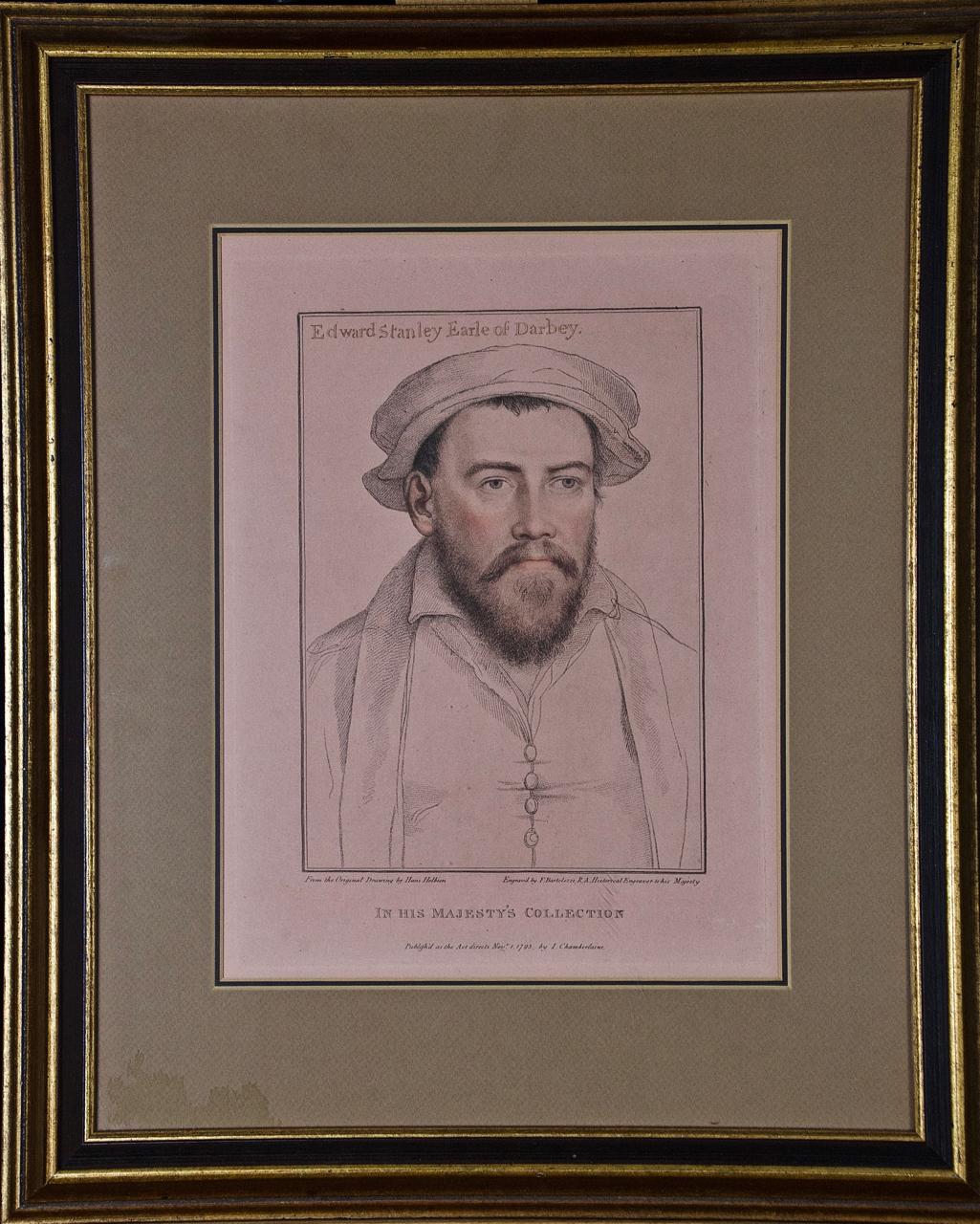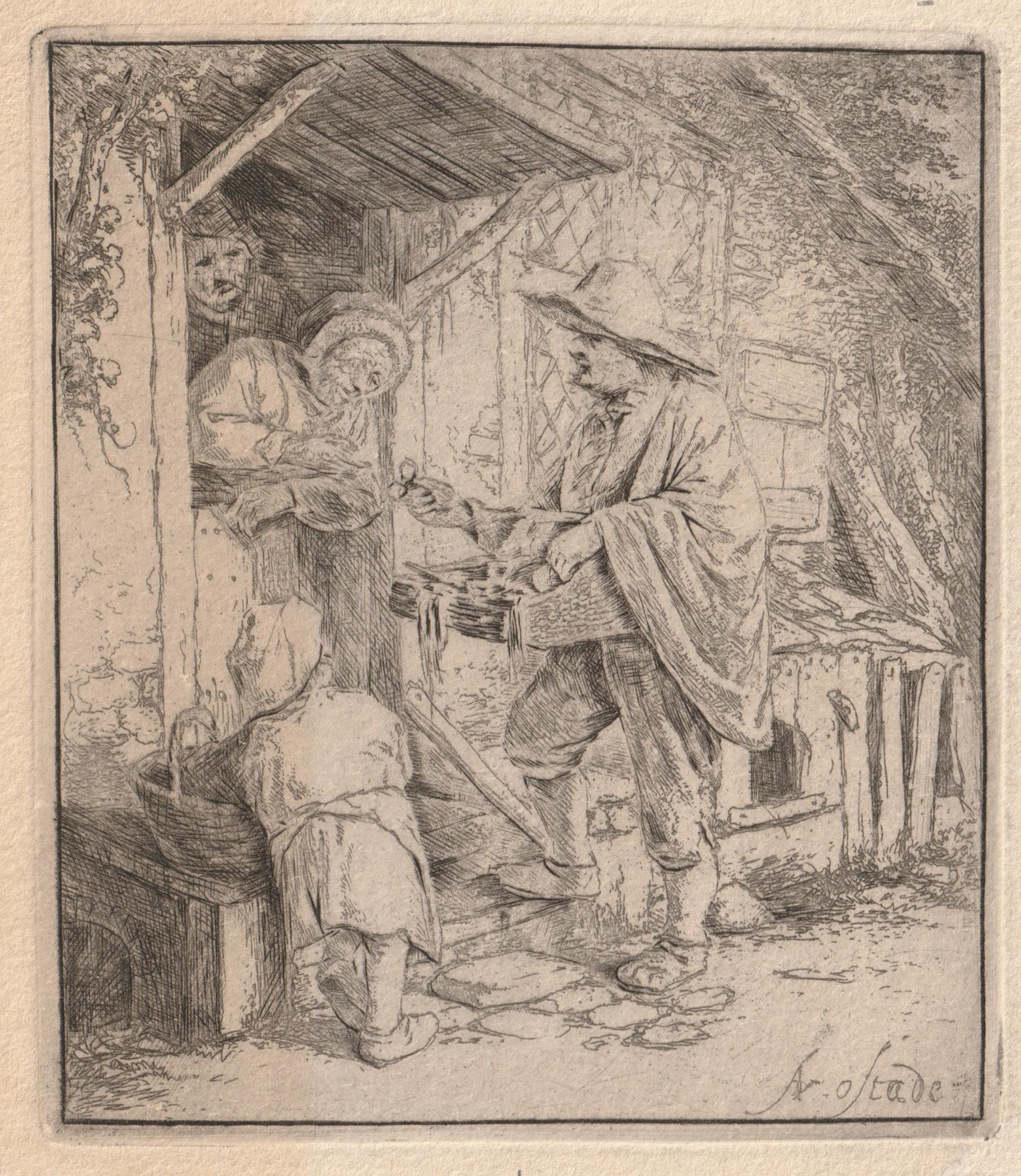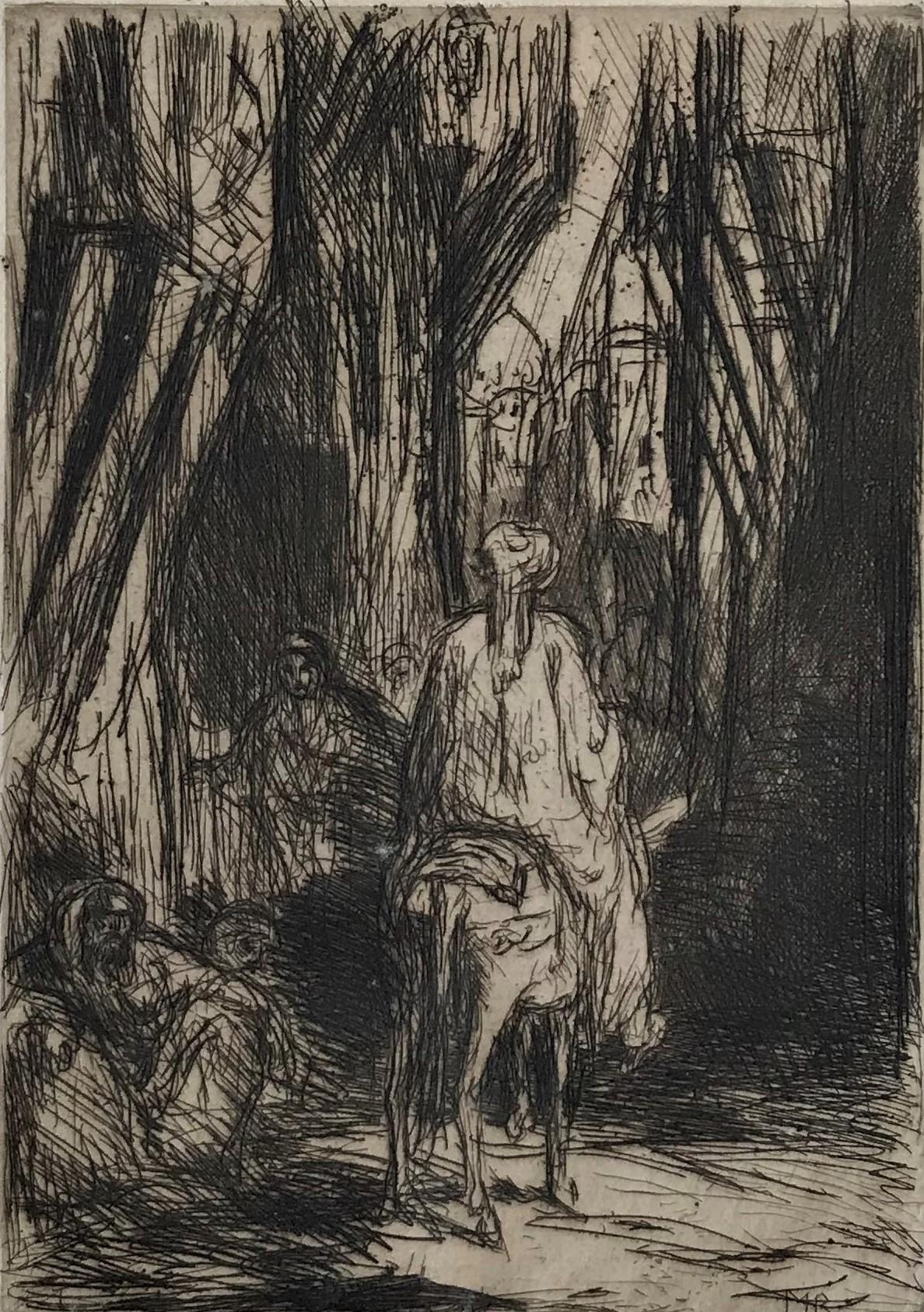Jacobus HoubrakenJohannes Wesselius Portrait: An 18th Century Engraving/Etching by Houbraken1741
1741
About the Item
- Creator:Jacobus Houbraken (1698 - 1780, Dutch)
- Creation Year:1741
- Dimensions:Height: 19 in (48.26 cm)Diameter: 13.5 in (34.29 cm)
- Medium:
- Movement & Style:
- Period:
- Framing:Framing Options Available
- Condition:
- Gallery Location:Alamo, CA
- Reference Number:
Jacobus Houbraken
Jacobus Houbraken was a Dutch engraver and the son of the artist and biographer Arnold Houbraken, whom he assisted in producing a published record of the lives of artists from the Dutch Golden Age. Houbraken was born in Dordrecht and learned the art of engraving from his father. In 1707 he moved to Amsterdam, where for years he helped his father with his magnum opus, his art historical work The Great Theatre of Dutch Painters (1718–21). When his father died, he assisted his mother with the last proofs of the manuscript before publishing. With this project, he started his portraits of Netherlandish celebrities, that are today in many cases the only likenesses left of these people. Houbraken was influenced by studying the works of Cornelis Cort, Jonas Suyderhoef, Gerard Edelinck and the Visschers. He died, aged 81, in Amsterdam.
- ShippingRetrieving quote...Ships From: Alamo, CA
- Return PolicyA return for this item may be initiated within 7 days of delivery.
- 18th C. Portrait of Edward Stanley from Henry VIII's Court after Holbein DrawingBy Hans HolbeinLocated in Alamo, CAThis is an 18th century engraved portrait of "Edward Stanley" created by Francesco Bartolozzi (1728–1815), after a drawing by Hans Holbein the Younger (1497- 1543) in the 16th century. Holbein was the official artist in the court of King Henry VIII. Bartolozzi used both etching and stipple engraving techniques to create the work which was published by John Chamberlaine in London in 1793 in "The Book of Imitations of Original Drawings by Hans Holbein in the Collection of His Majesty". Edward Stanley, 3rd Earl of Derby...Category
Late 18th Century Old Masters Portrait Prints
MaterialsEtching, Engraving
- 18th C. Bartolozzi Portrait of Brooke Cobham from a 16th Century Holbein DrawingBy Hans HolbeinLocated in Alamo, CAThis is an 18th century engraved portrait of Brooke Cobham, a nobleman in King Henry VIII's court, created by Francesco Bartolozzi (1728–1815), after a drawing by Hans Holbein the Younger (1497- 1543) in the 16th century. Holbein was the official artist in the court of King Henry VIII. Bartolozzi used both etching and stipple engraving techniques to create the work which was then was printed in color on pink paper and hand finished with watercolor. It was published by John Chamberlaine in London in 1793 in "The Book of Imitations of Original Drawings by Hans Holbein in the Collection of His Majesty". Sir George Brooke, Baron Cobham (1497-1558) was a prominent member of King Henry VIII's royal court. He became a member of parliament in 1529 and served as a peer in the trial of Queen Anne Boleyn, which resulted in her beheading. He was rewarded for his political and military service to King Henry and Britain with land, castles and former monasteries and was made a Knight of the Garter, a prestigious membership limited to the king and a very limited number of prominent British subjects. As a member of the Privy Council following the death of young King Edward VI (Henry VIII's son), he fell out of favor when he signed a ruling disinheriting both of Henry VIII's daughters, Mary and Elizabeth, in favor of Lady Jane Grey...Category
Late 18th Century Old Masters Portrait Prints
MaterialsEtching, Engraving
- Vincent de Paul Portrait: 17th C. Engraving by Edelinck in Perrault's Les HommesBy Gerard EdelinckLocated in Alamo, CAThis is a 17th century portrait engraving of Saint Vincent de Paul by Gerard Edelinck (1640-1707) after a painting by Simon Francois (1606-1671), published in Charles Perrault's 'Les Hommes Illustres' in Paris in 1696. Vincent de Paul (1581-1660) was a French Catholic...Category
Late 17th Century Old Masters Portrait Prints
MaterialsEngraving
- Jean Racine Portrait: 17th C. Engraving by Edelinck in Perrault's Les HommesBy Gerard EdelinckLocated in Alamo, CAThis is a 17th century portrait engraving of Jean-Baptiste Racine by Gerard Edelinck (1640-1707), published in Charles Perrault's 'Les Hommes Illustres' in Paris in 1696. Jean Racine (1639-1699) was a French dramatist, one of the three great playwrights of 17th-century France, along with Molière and Corneille. Racine's works were primarily tragedies. He wrote Phèdre, Andromaque, and Athalie. He did write one comedy, Les Plaideurs, and a muted tragedy, Esther for young readers. His writing is renowned for its elegance, purity, speed, and fury. The American poet Robert Lowell described his style as a "diamond-edge" and the "glory of its hard, electric rage". Racine's works often displayed his psychological insight, the passion of his characters, and the stark reality of his plots and stage descriptions. In 1672, he was elected to the Académie Française, and two years later he achieved the title of "treasurer of France", and later the honorary title of an "ordinary gentleman of the king" to King Louis XIV, and subsequently a secretary of the king . This beautiful engraved portrait is printed on chain-linked, laid paper with wide margins. The sheet measures 17.13" high by 10.75" wide. There is a small spot in the lower margin and a few tiny faint spots in the margins, but the print is otherwise in very good condition. The original descriptive text pages, 81 & 82, are included. Provenance: This engraving was owned by Arthur Pomeroy, 1st Baron Harberton and the Viscount Harberton (1723-1798). He was an Irish politician, who represented County Kildare in the Irish House...Category
Late 17th Century Old Masters Portrait Prints
MaterialsEngraving
- Ancient Roman Statues in the Vatican: A Grouping of Three 18th C. EngravingsBy Vincenzo DolcibeneLocated in Alamo, CAA grouping of three antique engravings depicting statues found in the Vatican, including: "Pescatore" (Fisherman), "Pastore" and "Istrione", "Gia nella Villa Mattei" (Found in the Vi...Category
1780s Old Masters Still-life Prints
MaterialsEngraving
- Portrait of William Pitt, Earl of Chatham: Rare Framed Mezzotint after BromptonBy Edward FisherLocated in Alamo, CAThis is a large framed very rare hand-colored copperplate mezzotint engraved portrait of William Pitt, the Elder, 1st Earl of Chatham by Edward Fisher, published in London in 1779 after a painting by Richard Brompton. Pitt is depicted attired in a flowing regal appearing cape, standing in an ornate room with his left hand outstretched over a serious of manuscripts and scrolls that are laying on a table or desk to his left. The table is covered by a beautiful oriental carpet. The manuscripts include the Magna Carta, a map of the colonies, including Long Island and Staten Island, and papers entitled "A Plan for the Reconciliation between Great Britain and the Colonies", "A Motion Made in 1775 for the Recall of Troops from Boston", "A Provisional Act for Settling the Troubles in America Offered to the House of Lords in 1775", and "It is doing Nothing to repeal a few Scraps of Paper or Pieces of Parchment called Acts of Parliament. But our Business is to repeal the Ill-Will and the Animosity unfortunately now subsisting between Great Britain and North America". This engraving is held by the British Museum and the British Royal Collection Trust. This large framed mezzotint engraving is presented in a brown wood frame with gold-colored beaded inner and outer trim, and a cream-colored French mat. The frame measures 31.63" high by 26.63" wide by 0.75" deep. There are three short tears along the right edge and mild creasing in the left upper, left lower and right lower corners. It is otherwise in very good condition. William Pitt (1708-1778) was a member of the British parliament from 1735 to 1761 and prime minister from 1766 to 1768. Pitt was an advocate for the American colonies leading up to the War of Independence. He called for an amiable relationship between Great Britain and the colonies and opposed the Stamp Act and military action in America. He advocated for a withdrawal of English troops from Boston in 1775 and the settling of troubles in America, as two of his manuscripts on the table outline. Pitt's colleague, Lord Shelburne (later the Marquess of Lansdowne) shared his sympathies and after Pitt's death, signed a peace treaty with the United States in 1782. The American city of Pittsburgh, Pennsylvania is named for William Pitt, the Elder. The name originated when the conflict between the British and French over territorial claims in the Northeast were settled in 1758. General John Forbes and his British army, supported by the American colonial troops, expelled the French from Fort Duquesne (which had been constructed by the French in 1754). Forbes re-named the site for William Pitt the Elder, who at the time was a British statesman. The earliest known reference to the new name, Pittsburgh, is in a letter sent from General John Forbes to Pitt, dated November 27, 1758. Pitt's son, William Pitt, the Younger, like his father, also served as British Prime Minister. Edward Fisher (1730-1785) was born in Ireland in 1730. He was originally a hatter, but learned engraving in London. He became a member of the Incorporated Society of Artists in 1766, and exhibited there fourteen times between 1761 and 1776. He engraved more than sixty portraits. In addition to this portrait of William Pitt, Earl of Chatham, after Richard Brompton he engraved several portraits after Brompton, including George, Earl of Albemarle, as well as engraved portraits after paintings by Joshua Reynolds, including the Shakespearean actor David Garrick, Hugh, Earl of Northumberland, and Elizabeth, Countess of Northumberland and Laurence Sterne, and Hope Nursing Love, as well as Robert Brown, after Mason Chamberlin, Colley Cibber, after Jean-Baptiste van Loo, Christian VII of Denmark, after Nathaniel Dance, Simon, Earl Harcourt, after Hunter, Roger Long, after Benjamin Wilson...Category
Late 18th Century Old Masters Portrait Prints
MaterialsMezzotint
- The Spectacle SellerBy Adriaen Jansz van OstadeLocated in Middletown, NYEtching and drypoint on cream laid paper, 4 x 3 3/8 inches (102 x 86 mm), 1/4 inch margins. Signed in the plate, lower left corner. The 3rd state (of 6), after the rounding of the pl...Category
Mid-17th Century Old Masters Figurative Prints
MaterialsDrypoint, Laid Paper, Etching
- Louis XI, Roi de FranceBy Jean MorinLocated in Middletown, NYEtching, engraving and stippling on cream laid paper with an indiscernible watermark in the sheet center, 11 15/16 x 8 3/16 inches (302 x 207 mm), trimmed at the plate mark. A very g...Category
Mid-17th Century Old Masters Portrait Prints
MaterialsLaid Paper, Engraving, Etching
- Carolus de Mallery, by Lucas Vorsetman the Elder after van DyckBy Rembrandt van RijnLocated in Middletown, NYAn exalted portrait of fellow Flemish engraver and publisher Karel van Mallery. Lucas Vorsterman the Elder (after Anthony van Dyck). Carolus de Mallery, from Icones Principum Viror...Category
Mid-17th Century Old Masters Portrait Prints
MaterialsLaid Paper, Engraving, Etching
- Street in SmyrnaBy Marius BauerLocated in Storrs, CTStreet in Smyrna. 1889. Etching. Wisselingh 34. 7 x 5 1/4 (sheet 12 7/8 x 8 7/8).Edition 100, number 49. A rich, tonal impression printed on Strasbourg cream laid paper on the full s...Category
Late 19th Century Old Masters Figurative Prints
MaterialsDrypoint, Etching
- San Benedetto Con Altri Nanti, religious engraving after Veronese, circa 1700Located in Melbourne, VictoriaReligious copper-line engraving by CM after Francesco Petrucci after (Paolo Caliari) Veronese. Depicts Saint Benedict and other holy figures. Paolo Vero...Category
Early 1700s Old Masters Portrait Prints
MaterialsEngraving
- Self-portrait - Engraving after Rembrandt -19th CenturyBy Charles Amand DurandLocated in Roma, ITSelf-portrait is an engraving on ivory-colored paper realized after an etching by Rembrandt dated 1645. This wonderful piece of art belongs to an edition of the late 19th century. ...Category
19th Century Old Masters Figurative Prints
MaterialsEngraving






